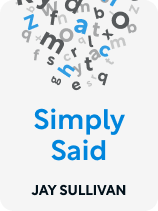

This article is an excerpt from the Shortform book guide to "Simply Said" by Jay Sullivan. Shortform has the world's best summaries and analyses of books you should be reading.
Like this article? Sign up for a free trial here .
Do you want to level up your communication skills? What are some things you should keep in mind when it comes to oral communication?
Effective oral communication is one of the most important skills you could develop. One rule of thumb to keep in mind is to use the same techniques whether you’re talking with one person or a roomful of people—maintain the same level of confidence, attention, and engagement.
Here’s how to improve your oral communication skills, according to author Jay Sullivan.
How to Improve Your Oral Communication Skills
Being a competent communicator will open many doors for you, both in a personal and a professional sense. Here are a few tips on how to improve your oral communication skills.
Tip #1: Mind Your Voice
Sullivan advises paying attention to the speed, volume, and tone of your voice:
Speed: You’ll more likely need to slow your pace rather than speed it up—most people talk fast out of nervousness. (Sullivan does add that talking fast on purpose can imply a sense of urgency.) Also, incorporate pauses to give your audience time to process what you just said. (Shortform note: What’s so bad about talking fast? Not only does it make you appear less confident and unorganized, it also makes your audience work harder to understand you—which goes against Sullivan’s advice to focus on their needs. Work on your pace by recording yourself as you practice your presentation. From there, you can gauge exactly how fast you’re talking and make adjustments. A good rate to aim for is 150-160 words per minute.)
Volume: When speaking without a microphone, Sullivan recommends projecting your voice enough to reach the person farthest away from you. Deliberately varying your volume can keep people more engaged. Saying something loudly can emphasize a point; counterintuitively, lowering your voice on occasion can encourage them to lean in and listen more intently. (Shortform note: Remember that projecting your voice is different from yelling—yelling uses your vocal cords, while projecting uses your diaphragm, or the muscle at the base of your chest. To practice using your diaphragm, try this exercise: Take a big breath in, feeling your abdomen expand, then force all the air out with a “ha.” You should feel your diaphragm contract.)
Tone: Inject energy and positivity into your tone by delivering your message with a smile. Avoid sounding lifeless, which tends to happen when you read your notes in a monotone voice. However, Sullivan cautions that while varying your tone, you should avoid “upspeak”—using a rising inflection at the end of a declarative sentence, making it sound like a question. This type of tone makes you sound tentative. (Shortform note: Sullivan says you should avoid upspeak, which is often derided as an undesirable practice, but others argue that it has a necessary function: Contrary to the belief that it makes you sound tentative, it may actually encourage other people to listen actively and discourage them from interrupting.)
Tip #2: Use Eye Contact to Connect With Your Audience
Every time you say something, make eye contact with members of the audience. However, Sullivan says your eyes shouldn’t constantly dart around the room. The proper way to make eye contact when presenting to a group is to look at one person for as long as it takes to complete a sentence. Then, move on to another person. Give key decision-makers more attention, but don’t ignore all the other people in the room—you want to make your whole audience feel like you’re connected to them.
In a one-on-one conversation, Sullivan advises gauging the other person’s comfort level with eye contact; if they seem uncomfortable holding your gaze, drop your eyes from time to time while you’re not talking, perhaps to jot down a note. (Shortform note: While Sullivan isn’t specific, some communication experts recommend maintaining eye contact 50% of the time while speaking and 70% while listening.)
Tip #3: Communicate Openness and Confidence With Your Body
The author says that your body language should be open and neutral, whether you choose to stand or sit:
Standing: Stand with your feet directly under your hips with your weight evenly distributed and your hands apart—this keeps you from fidgeting or crossing your arms, which makes you look closed off. It also leaves you free to use hand gestures to emphasize your points.
Seated at a table: Sit up straight and stay still (no swiveling), keeping your forearms on the table with your hands on either side of your notes.
Sullivan adds that your facial expression should convey that you want to be there; even if you’re delivering bad news and deem it inappropriate to smile, wear a sincere expression that shows you’re ready and willing to provide support.
Tip #4: Listen Well
Oral communication skills aren’t just about talking—listening is equally important, because it enables you to understand the other person and gain their trust and respect. Listening is an important element of Sullivan’s core message of focusing on the other person.
He recommends you treat a conversation not as an opportunity to grandstand but as a chance to learn more about the other person’s needs. For example, if you’re in a client meeting, keep asking questions until you uncover useful information.
The type of questions you ask will depend on your objective:
- Ask closed questions if you need specific information from the other person—for example, “Can you complete this by 4 p.m. on Thursday?”
- Ask open-ended questions if you want a deeper, nuanced response—for example, “Why do you think that is?” It’s also a good opportunity to show the other person that you’re there for them by asking questions like “What can I do to help?”
(Shortform note: Keep in mind that you may have to read between the lines when it comes to their answers—people tend to respond differently based on their status or level of power in relation to yours. Culture also plays a part: For example, Asian cultures tend to be disagreement-avoidant because they believe that disagreeing can damage relationships.)
If you’re unsure about what the other person is trying to say, clarify using three steps:
- Step 1: Start with an introductory phrase (“If I understood it correctly…”).
- Step 2: Restate what they said. You can use the exact words they used or, if they didn’t say it clearly, rephrase it to reflect their message.
- Step 3: End with a question to confirm your understanding (“Did I get that right?”).
Tip #5: Answer Questions With Ease
When fielding questions from your audience, Sullivan warns against latching onto specific words and thinking of an answer before you hear the whole question. Once you know exactly what they’re asking, restate the question or comment on what they said (“That’s a great point”) to buy time to come up with a response. Answer briefly without digressing, then move on to the next question.
(Shortform note: If you’re nervous about fielding questions, you can ease your anxiety by being prepared and considering what you would ask if you were in the audience’s place. Questions usually revolve around three themes: 1) the downside for the audience, 2) how your message links to their other concerns, and 3) what your message means going forward.)
If the question is emotional rather than rational, Sullivan recommends the following strategy: First, acknowledge what the other person is feeling (“I understand your concerns”). Second, empathize with what they’re feeling (“I also had the same worries”). Lastly, answer briefly, perhaps offering other options.
(Shortform note: Sullivan recommends showing empathy when you answer an emotional question. You can do this by tapping into skills that create empathy that Brené Brown outlines in Dare to Lead: 1) Take the other person’s perspective (which echoes Sullivan’s main premise), 2) be nonjudgmental, 3) understand how the other person feels and be able to articulate this understanding, and 4) manage your own emotions so that you’re neither suppressing nor exaggerating them.)

———End of Preview———
Like what you just read? Read the rest of the world's best book summary and analysis of Jay Sullivan's "Simply Said" at Shortform .
Here's what you'll find in our full Simply Said summary :
- A blueprint for effective business communication
- How to create and deliver memorable presentations
- How to write documents and emails that people will actually read






